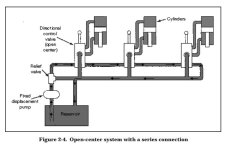Let me take a shot at it, maybe I can help. Lets simplify to a single control valve and a single cylinder. Fluid comes from pump to valve, and valve is in neutral, fluid flow never develops any pressure as there is not much resistance to the fluid flow, so pressure is extremely low, just a tiny amount from resistance of hose walls and valve passages. So far so good?. Remember pumps don't make pressure, pumps make flow.
Now we throw the valve to direct the flow of fluid from the pump to the cap end (big end) of the cylinder. As the rod starts to move out of the way of the incoming fluid some pressure is developed, and if that rod has a big weight pushing down on it (like a load on the loader arm for instance) Then that pressure will develop in a hurry. So lets say that load on the rod makes 2000 psi develop in the cap end of the cylinder, and the load starts to rise. Fluid keep coming in from the pump thru the valve passages and into the cap end of the cylinder. so far so good?
Now the rod end of the cylinder is full of fluid too. Not from this operation of applying fluid to the cap end, but from the last time we applied fluid to the rod end. That fluid didn't go any where it just sits in there. But now that fluid has to be evacuated because the cap end has all that pressure on the other side, and you have to get that old fluid out of the rod end or if you don't then since fluid is not compressable, a high pressure would instantly develop and the cylinder would be locked.
BUT on our simple single valve, it has a second set of passages that when you changed the passages to apply fluid to the cap end from the pump, you also opened a second set of passages that go from the rod end of the cylinder to the "tank" otherwise know as the reservoir or transmission of the tractor. So now this old fluid in the rod end of the cylinder has somewhere to go now that the cap end keeps on pushing against that load and the loader keeps on rising, this old fluid is pushed out back to the tank.
Now lets say instead of raising the load to the limits of the cylinder travel, we just raised it half way and then returned the control valve to neutral. So now the cylinder is locked in place with no place for the fluid in either end of the cylinder, on both sides of the piston seals to go anywhere. It is trapped in there.
Now, you decide to slowly lower the load and you shove the control valve from neutral to the lower position. Now the fluid path is from pump to the control valve input then out the work port that attaches to the rod end this time of the cylinder. Fluid starts to flow into the rod end, and the old fluid in the cap end of the cylinder is returned to tank. This will now be low pressure "dead" fluid. So far so good?
Now lets say we want to operate some other valve and cylinder like maybe the 3pt. Ok, your loader valve is going to need one of those PB (Peanut Butter

) valves to pass that pump flow on thru the this loader valve so that it will have flow to lift that 3pt cylinder.
Note that you loader valve is still going to need a tank connection, to get rid of those "dead" fluid flows like when we evacuate the other sided of cylinders. So our loader valve will have 1: pump input 2: return to tank 3: PB Power Beyond. And the two work ports, one connected to the cap end of our cylinder and one connected to the rod end of the cylinder. Of course a real loader control also wants to control the bucket angle as well as the lift, so it has a second set of work ports, and you activate these by moving the stick side to side instead of back and forth.
Now we did not address either Float or Regeneration or relief valves in our discussion of the valve and cylinder or extra cylinders etc.. I am trying to keep it simple.
Take aways: 1 Pumps make flow NOT pressure. 2: Pressure rises when flow meets a restriction. 3: cylinders have a cap end and a rod end, both have fluid in them at all times. 4: you have to get rid of "dead or used" fluid from the opposite end, or the cylinder will not move. 5: simple control valves are not simple. They have multiple passageways and ways to match up these passageway to direct the fluid flows to accomplish what you want to do.
I hope this helped.


